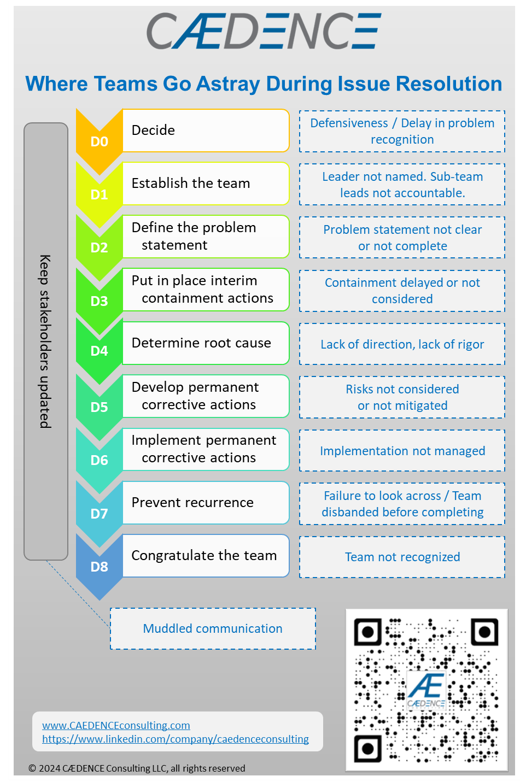Where do teams go astray during issue resolution?

We help a lot of teams get back on track after they struggle to promptly and effectively resolve customer issues. This infographic summarizes the most common spots in the issue resolution process where we see teams lose their way.
Many teams and companies struggle to get the most out of structured problem solving methodologies because they make one or more of the common mistakes shown, and they don’t even realize they’re doing it! (We’ve shown the 8D process here, but whether your company uses 8D, Six Sigma DMAIC, PDCA, A3, or another paradigm doesn’t matter.) The issue is HOW any of those methodologies are used by real teams in real time in the real world.
When clients ask us to intervene, it’s because a problem has been going on for too long and their customer is upset. Invariably, we have to rectify several of the behaviors shown, usually starting with the issue resolution team structure and clarification of the problem statement. Driving containment, driving planning and rigor in root cause analysis, and unscrambling the garbled communication that undermines customer confidence are the typical next steps. We have yet to find an organization that does a truly robust job at preventing recurrence on related products.
CAEDENCE is here to help. Our team specializes in intervening in troubled projects and getting them on-track. Preventing the next catastrophe by strengthening clients’ design and process development, quality systems, and communication skills is where we really shine.
Our clientele ranges from startups to Fortune 500 companies and spans automotive, semiconductor, aerospace and other industries. DM us today for a free, no obligation discussion about the issues you’re facing.

Over the years we’ve been exposed to Six Sigma, Juran, Deming PDCA, 8D, Dale Carnegie, A3, Shainin, and more. Each technique works pretty well, and has been demonstrated many times in a wide variety of industries and circumstances. At the core they are all essentially the same!
Each approach relies on an underlying logical flow that goes like this: [a] make sure the problem is clearly defined; [b] be open to all sources of information; [c] vet the information for relevance and accuracy; [d] use the process of elimination to narrow down all possible causes to the most likely few; [e] prove which of the suspects is really the cause of the issue; [f] generate a number of potential solutions; [g] evaluate the effectiveness, feasibility and risk of the potential solutions; [h] implement the winning solution(s); and [i] take steps to make sure your solution(s) don’t unravel in the future.
The differences between the paradigms resides in supplementary steps and toolkits. For example, 8D contains the important “In









